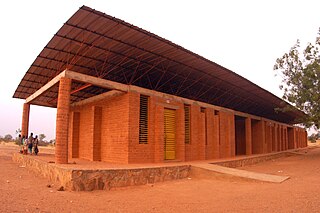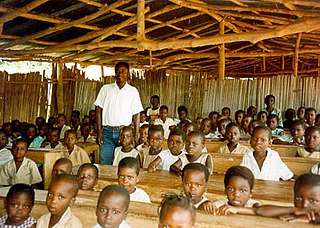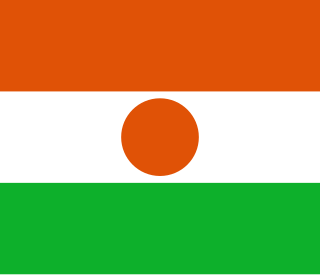
Education in Burkina Faso is structured in much the same way as in the rest of the world: primary, secondary, and higher education. As of 2008, despite efforts to improve education, the country had the lowest adult literacy rate in the world (25.3%).

Education in Bolivia, as in many other areas of Bolivian life, has a divide between Bolivia's rural and urban areas. Rural illiteracy levels remain high, even as the rest of the country becomes increasingly literate. Bolivia devotes 23% of its annual budget to educational expenditures, a higher percentage than in most other South American countries, albeit from a smaller national budget. A comprehensive, education reform has made some significant changes. Initiated in 1994, the reform decentralized educational funding in order to meet diverse local needs, improved teacher training and curricula, formalized and expanded intercultural bilingual education and changed the school grade system. Resistance from teachers’ unions, however, has slowed implementation of some of the intended reforms.

Education in Chad is challenging due to the nation's dispersed population and a certain degree of reluctance on the part of parents to send their children to school. Although attendance is compulsory, only 68% of boys continue their education past primary school, and over half of the population is illiterate. Higher education is provided at the University of N'Djamena.

Practically all children attend Quranic school for two or three years, starting around age five; there they learn the rudiments of the Islamic faith and some classical Arabic. When rural children attend these schools, they sometimes move away from home and help the teacher work his land.
During Alfredo Stroessner Mattiauda’s presidency (1954–89), education initiatives took a backseat to economic concerns and the task of controlling political adversaries, and teacher salaries fell to extremely low levels. The constitution of 1992 attempted to remedy the long neglect of education. Article 85 of the constitution mandates that 20% of the government budget be designated for educational expenditures. This measure, however, has proven to be impractical and has been largely ignored.

Education in Dominica is compulsory from ages 5 to 16. The gross primary enrollment rate was 100.4 percent in 1991 and 98.2 percent in 1998, and the net primary enrollment rate was 88.7 percent in 1991 and 88.8 percent in 1998. Primary school attendance rates were unavailable for Dominica as of 2001. Poor physical conditions in many primary schools affect the quality of education, while some schools are overcrowded, limiting access to primary education, particularly for children living in urban areas around the capital. Poverty and work on family banana farms during the harvest season can affect school attendance, but other employment does not pull minors out of school. There is a significant Carib Indian population in Dominica, and schools on the Carib Territory are reported to have fewer resources.
Education in Grenada is free and compulsory between the ages of 6 and 14 years. In 1998, the gross primary enrollment rate was 125.5 percent, while the net primary enrollment rate was 97.5 percent. Despite the high enrollment rate, poverty, poor school facilities, and the periodic need to help with family farm harvests have resulted in approximately a 7 percent absenteeism rate among primary school children.
Education in Saint Vincent and the Grenadines is neither compulsory nor free, although children are usually in school until the age of 15. In 1998, the gross primary enrollment rate was 90.5 percent, and the net primary enrollment rate was 83.5 percent.
The Ecuadorian Constitution requires that all children attend school until they achieve a “basic level of education,” which is estimated at nine school years.
Education in Georgia is free of charge and compulsory from the age of 6 until 17-18 years. In 1996, the gross primary enrollment rate was 88.2 percent, and the net primary enrollment rate was 87 percent; 48.8 percent are girls and 51.8 percent are boys. Constitution mandates that education is free. Related expenses that include textbooks and laptops are provided by the state free of charge; in 2001 there were 47,837 children not attending primary school.

Benin has abolished school fees and is carrying out the recommendations of its 2007 Educational Forum. In 2018, the net primary enrollment rate was 97 percent. Gross enrollment rate in secondary education has greatly increased in the last two decades, from 21.8 percent in 2000 to 59 percent in 2016, 67.1 percent in the case of males and 50.7 percent for females. Because of a rapid increase in the enrollment rate, the student/teacher ratio rose from 36:1 in 1990 to 53:1 in 1997 but has dropped again in the last years to 39:1 (2018). In 2018, the gross enrollment ratio in tertiary education was 12.5%.

Education is compulsory in Burundi for the six years between the ages of seven and 13. Theoretically, primary education is free at point of use.

Primary school education in Cape Verde is mandatory between the ages of 6–14 and free for children ages 6–12. In 1997, the gross primary enrollment rate was 148.8%. Primary school attendance rates were unavailable for Cape Verde as of 2001. While enrollment rates indicate a level of commitment to education, they do not always reflect children's participation in school. Textbooks have been made available to 90% of school children, and 90% of teachers have attended in-service teacher training. Its literacy rate as of 2010 ranges from 75 to 80%, the highest in West Africa south of the Sahara.

Public education in the Central African Republic is free, and education is compulsory from ages 6 to 14. AIDS-related deaths have taken a heavy toll on teachers, contributing to the closure of more than 100 primary schools between 1996 and 1998.

Primary education in Guinea is compulsory for 6 years. In 1997, the gross primary enrolment rate was 54.4 percent and the net primary enrolment rate was 41.8 percent. Public education in Guinea is governed by three ministries: The Ministry for Pre-University Education and Literacy; The Ministry for Technical Education and Occupational Training; and the Ministry for Higher Education, Scientific Research and Innovation.
Education in Lesotho has undergone reforms in recent years, meaning that primary education is now free, universal, and compulsory.

Education in Niger, as in other nations in the Sahelian region of Africa, faces challenges due to poverty and poor access to schools. Although education is compulsory between the ages of seven and fifteen, with primary and secondary school leading into optional higher education, Niger has one of the lowest literacy rates in the world. With assistance from external organizations, Niger has been pursuing educational improvement, reforming how schools utilize languages of instruction, and exploring how the system can close gender gaps in retention and learning.
Education in Togo is compulsory for six years. In 1996, the gross primary enrollment rate was 119.6 percent, and the net primary enrollment rate was 81.3 percent. Primary school attendance rates were unavailable for Togo as of 2001.
Primary school education in Fiji is compulsory, and subsidised for eight years. In 1978, the gross primary enrollment ratio was 113.5 percent, and the net primary enrollment rate was 97.7 percent. As of 2009, attendance was decreasing due to security concerns and the burden of school fees, often due to the cost of transport. In 2013, the Bainimarama government made education at the primary and secondary level in Fiji free for all students. Fiji has since achieved universal access to primary education.
.
Education in Kiribati is free and compulsory from age 6 to 14, which includes primary school through grade six, and Junior Secondary School for three additional grade levels. In 1998, the gross primary enrollment rate was 84.4 percent, and net primary enrollment rate was 70.7 percent. School quality and access to education are better in urban areas; schools in small communities on isolated islands are expensive to maintain. Mission schools are slowly being absorbed into the government primary school system.
![Universidad Metropolitana de Honduras [es] Este es el primer campus de la Universidad Metropolitan de Honduras.jpg](http://upload.wikimedia.org/wikipedia/commons/thumb/5/53/Este_es_el_primer_campus_de_la_Universidad_Metropolitan_de_Honduras.jpg/220px-Este_es_el_primer_campus_de_la_Universidad_Metropolitan_de_Honduras.jpg)













